Giochi dell'Oca e di percorso
(by Luigi Ciompi & Adrian Seville)
(by Luigi Ciompi & Adrian Seville)

|
Giochi dell'Oca e di percorso
(by Luigi Ciompi & Adrian Seville) |

|
 |

Torna alla ricerca giochi (back to game search) |
 |
| Wallis's New Game of Universal History and Chronology | ||
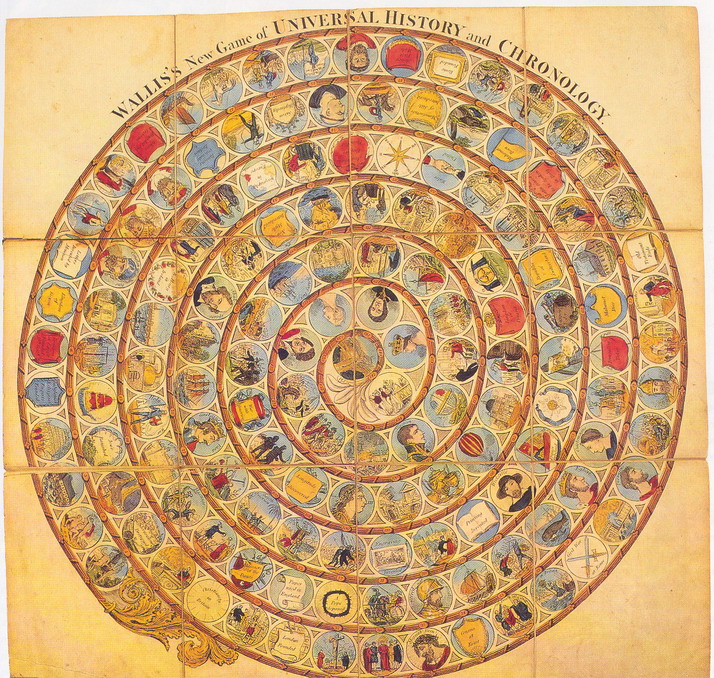 |
Versione stampabile
 |
Invia una segnalazione

|
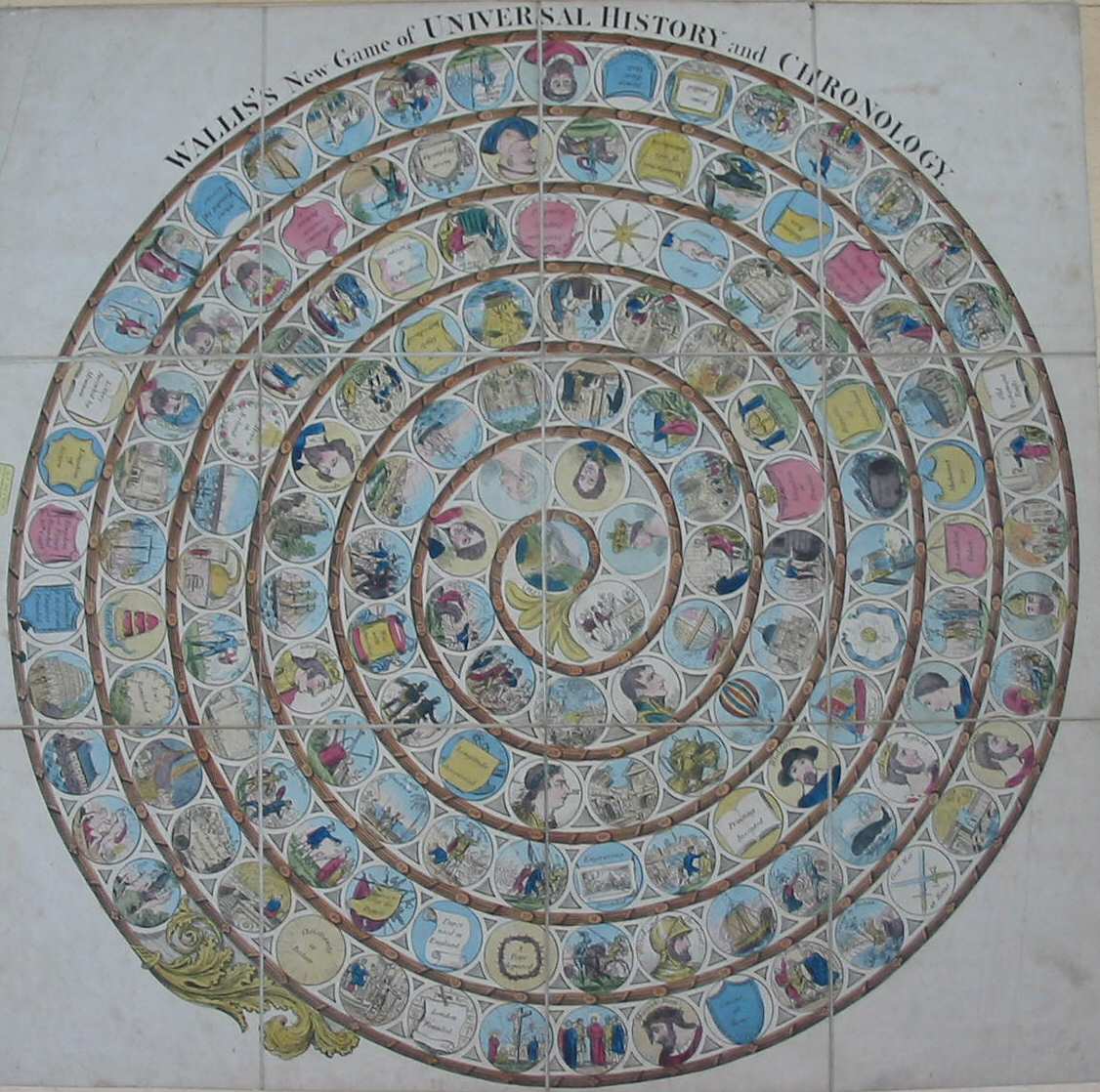 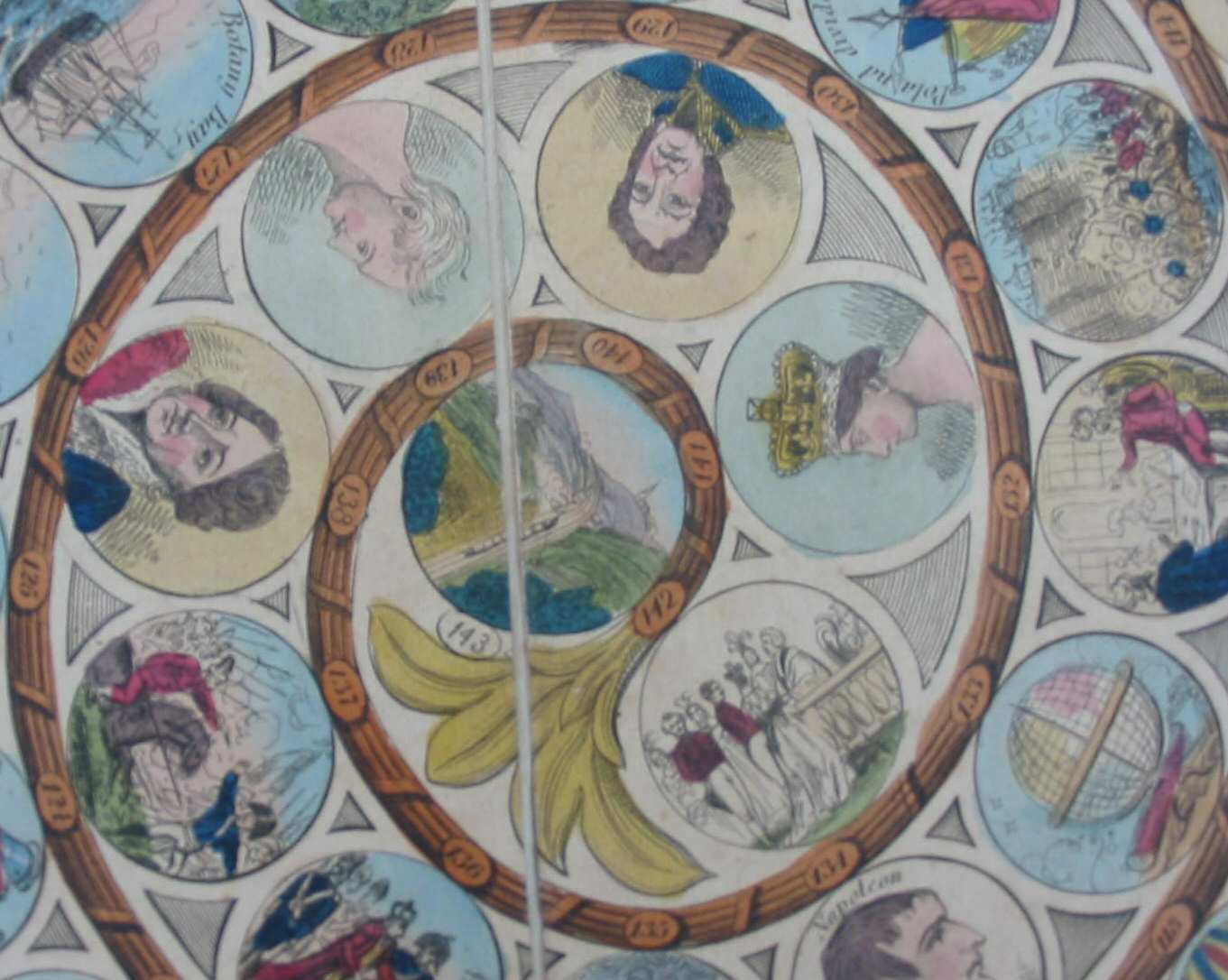 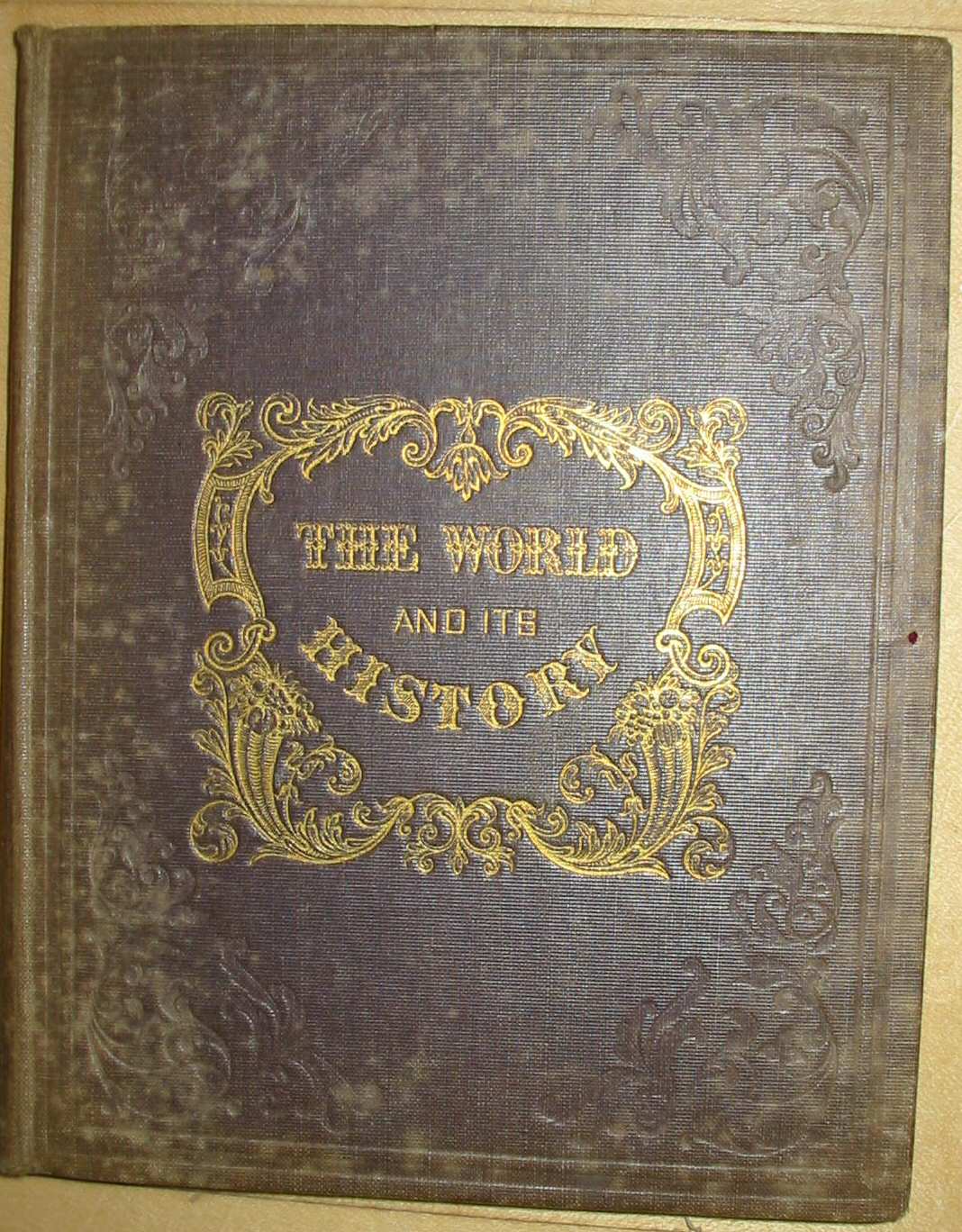 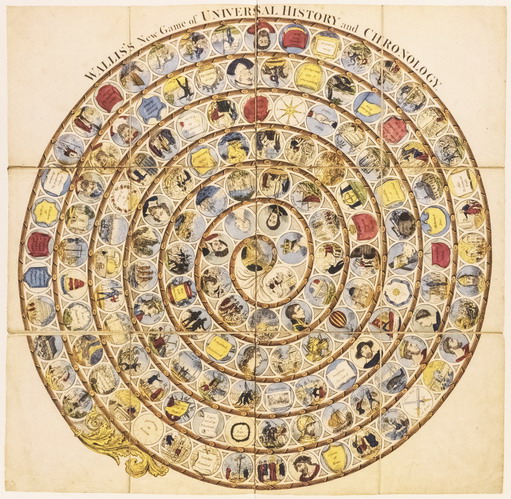 |
primo autore: | Cruikshank, Isaac Robert |
| secondo autore: | Wallis | |
| anno: | 1840 | |
| luogo: |
Inghilterra-Londra |
|
| periodo: | XIX secolo (2°/4) | |
| percorso: | Percorso di 143 caselle numerate | |
| materiale: | carta incollata su tela (engraving on paper with linen backing) | |
| dimensioni: | 530X530 | |
| stampa: | Litografia colorata a mano (hand-coloured engraving) | |
| luogo acquisto: | ||
| data acquisto: | ||
| dimensioni confezione: | 200X140 | |
| numero caselle: | 143 | |
| categoria: | Personaggi ed eventi storici | |
| tipo di gioco: | Gioco di percorso | |
| editore: | Wallis, John | |
| stampatore: | Wallis, John | |
| proprietario: | Collezione L. Ciompi | |
| autore delle foto: | L. Ciompi | |
| numero di catalogo: | 545 | |
| descrizione: |
Gioco di 143 caselle numerate, circolare, orario, centripeto modificato nel 1840 (la casella centrale del Principe Reggente viene sostituita da 5 nuove caselle. Vedi sotto descrizione esemplare originale del 1814. REGOLE:non riportate sul tavoliere. CASELLE: alcune con didascalia. NOTA: vedi altro esemplare Arch. n°854 PERSONAGGI: Socrates; Alexander the Great, 356-323 B.C.; Darius I King of Persia, 548-485 B.C.; Dionysius I, ca. 430-367 B.C.; Caesar, Julius; Jesus Christ; Constantius I Emperor of Rome, d. 306; Muhammad Prophet, d. 632; Charlemagne Emperor, 742-814; Alfred King of England, 849-899; Henry I King of England, d1068-1135; Wycliffe, John, d. 1384; Columbus, Christopher; Gustaf I Vasa King of Sweden, 1496-1560; Shakespeare, William, 1564-1616; Charles I King of England, 1600-1649; George III King of Great Britain, 1738-1820; Napoleon I Emperor of the French, 1769-1821; Fergus; Pharamond; Egbert II, King of England. REFERENZA 1 V&A Museum This game from 1840 is a reworked issue of the 1814 edition of the game and the central area of the game has been updated to reflect later historical events. The earlier game had at its centre a portrait of George IV as Prince Regent. This has been replaced with five further playing spaces including William IV and Queen Victoria, the Marriage of Queen Victoria and a railway train running through an embankment. Physical description Design: reworked version, etching hand coloured to show 143 medallions N°of squares: 143 Squares illustrated: all Square numbering: numbered 1 to 143 Squares titled: none, see booklet Subject of starting square: creation of the world Subject of ending square: train running through an embankment no booklet Place of Origin: London Date: ca. 1840 Artist/maker: Wallis, John Materials and Techniques: Hand-coloured engraved paper on linen Dimensions: Length: 53 cm; width: 53 cm. Cover: Length: 20 cm; width: 14 cm Object history note: the extra 5 squares take the place of the portraint of George IV to include William IV and Queen Victoria, the Marriage of Queen Victoria (142 and a railway train running through an embankment (143) Historical context note Rewards: receipt of counters Forfeits: payment of counters payment of counters N°of Players: up to 12 Equipment required: teetotum, markers and counters Rules: THE RULES OF PLAY WILL BE SIMILAR TO THE CHRONOLOGY GAME, WITH THE EXCEPTION OF THE REWORKED AREAS. IT IS PROBABLE THAT A BOOKLET DID ONCE EXIST AND PLAY WOULD NEED TO BE ADJUSTED TO FIT THE NEW SQUARES IN. EXPLANATION TO WALLIS'S NEW GAME OF UNIVERSAL HISTORY AND CHRONOLOGY, LONDON PRINTED FOR JOHN WALLIS No. 42 SKINNER STREET; BY F VIGURS, 14, YORK STREET, COVENT GARDENS, 1814 RULES FOR PLAYING Rule 1. The materials for playing this Game are, a Teetotum, which is to be numbered with pen and ink; twelve letters, or markers, to place on the numbers at which each player stands in the Game; and two dozen fish or counters for each, which may be pieces of card, or any other substance. II. Let the letters be placed on the table, face downwards; and each player draw one, which is to be his marker. Whoever has the earliest letter in the alphabet, is to spin first, and the others follow in rotation. III . Each player must put six counters into the pool. IV. Let the first player spin, and, placing his marker on the Game according to the number turned up, refer to the Chronology of Events, and observe the directions there given. V. Whenever a player is directed to read the history of any event in another page, he shall have the privilege, after so doing, of spinning again, and be rewarded with a counter from each player. VI. The fines placed on any number are only to be taken by those who arrive at it by spinning; and not when sent from another number; neither are the directions to be then observed. VII. If two persons arrive at the same number, the last comer shall return to his former place, and receive two from the first for so doing. (This is the opposite to that of Game of Human Life).. VIII.After the Game has gone once round, the first player is to spin again, and add that number which turns up to his f former one. Thus, if he were at 8, and at his second spin turn up 6, he moves to 14; and in this manner proceed till some one arrive at 139; but whoever goes beyond that must return to his former place, till some one arrive at the lucky number, who takes all the counters and wins the game. Within the booklet is a list of the squares; their titles and the dates applied to each, for example ANNO MUNDI 1 The creation of the World and AM 1656 The Universal Deluge.. Also within the booklet are the OUTLINES OF HISTORY given for some but not all the squares. These also contain some rewards and forfeits instructions and in general are meant to be read aloud by the players who land on the chosen squares. 139 - 1820 His Majasty George IV created king following the death of his father, 140 - 1833 The abolition of colonial slavery during the reign of William IV 141 - 1837 Queen Victoria ascended the throne at the age of eighteen. 142 - 1840 Marriage of Queen Victoria to Prince Albert of Saxe-Coburg and Gotha 143 - A completion of your journey upon the railway. Take possession of the Pool and proclaim the game at an end. Rules placement: no booklet Descriptive line: Hand coloured historical race game, Universal History and Chronology, published in England by John Wallis about 1840 REFERENZA 2 WHITEHOUSE, Francis Reginald Beaman, (pag. 30): UNIVERSAL HISTORY & CHRONOLOGY (Wallis’s new game of). An engraving size 20 ½ in X 20 in, hand-coloured and mounted in 12 sections on linen, folded into boards leather-covered and stamped in gilt “LOCOMOTIVE GAME". The track comprises 143 circles. Starting at No 1, Adam and Eve, it records outstanding events until 143 -A Railway Train-ends the game. Undated, but after 1840. The Historical Pastime games just described although spanning a period of over 40 years, follow each other with astonishing similarity. (A) GEORGE III published 1803 by Harris & Wallis. - GEO. III JUBILEE published 1810 by John Harris. (B) GEORGE-PRINCE REGENT published 1814 by John Wallis. (C) GEORGE IV N.D. (1828) by E. Wallis & J. Harris, (D) WILLIAM IV N.D. (1832) by E. Wallis & J. Harris, (E) VICTORIA N.D. (1840) by E. Wallis & J. Harris. (F) VICTORIA (Lithograph) N.D. (1842) by Passmore. (G) VICTORIA (Universal History and Chronology) N .D. (1844) by Wallis. REFERENZA 3 "Cependant, certains jeux commencent à partir d'Adam et Eve. Sur les 138 cases illustrées du New Game of Universal History and Chronology (Nouveau jeu de l'histoire et de la chronologie universelle) de John Wallis, les 75 premières sont consacrées à des événements antérieurs à 1066. Chaque case est datée, commençant par l'an 1 de notre ère, et toutes les dates sont précises meme si certaines nous paraissent aujourd'hui assez fantaisistes et peu crédibles - par exemple, ici le Déluge date de 1636 av. J. C.. Au centre se trouve George, prince régent (futur roi George IV). Une autre version éditée vers 1840 avait cinq compartiments au lieu du portrait. Parmi les nouveaux sujets se trouvait également le roi Guillaume IV et la reine Victoria, le mariage de la reine Victoria et une locomotive. Le règlement qui accompagnait le premier exemplaire donnait de brèves descriptions sur chaque case et quelques instructions et à la fin du livret se truvaient de longues descriptions de certains des sujets qui devaient etre lus à haute voix si un des joueurs tombait sur un certain nombre. Ce jeu est une gravure peinte à la main, édité le 20 mai 1814 par John Wallis". (GOODFELLOW Caroline) REFERENZA 4 "A few games do, however, begin with Adam and Eve. Out of the 138 compartments illustrated on John Wallis's "New Game of Universal History and Cronology", the first 75 are devoted to events before 1066. Each compartment has a date, starting at Anno Mundi 1 and all the dates are given with such conviction - for example, the Universal Deluge occurred in AM 1636 - that one wonders if this knowledge was lost between 1814 and today. In the centre is George, Prince Regent (later King George IV). A reworked impression of this game was published in about 1840, and had five compartments replacing the portrait. Among the new subjects were King William IV and Queen Victoria, and a railway train. Both versions of the game were hand-coloured. The rules booklet that accompanied the earlier example gave brief descriptions of each compartment and some directions, and at the end of the booklet were longer descriptions of some of the subjects, which had to be read aloud if a player landed on the revelant number. The game was a hand-coloured engraving published by John Wallis on May 20th 1814". (GOODFELLOW Caroline) REFERENZA 5 Wallis's New Game of Universal History and Chronology - Wallis’s neues Spiel der allgemeinen Geschichte und Zeitlaeufte London, um 1840 Radierung, handkoloriert, 53 x 53 cm Verlag: John Wallis Sammlung: Victoria and Albert Museum, London (Inv.-Nr.: 15.1783-1954) Wie kaum ein anderes Spiel ist Wallis's New Game of Universal History and Chronology (of the most remarkable Events) ein hochtourig laufender, nachgerade endlos produzierender Geschichtengenerator. Erzaehlt wird eine Geschichte der Menschheit von der Schoepfung bis in die spaeten 1830er-Jahre, ohne jede Beschraenkung der Themen entlang einer Fuelle von Ereignissen, Figuren und Jahreszahlen. Dem praechtig kolorierten Spielplan ist eine Broschuere mit Kommentaren beigegeben, die Spieler sind eingeladen (respektive verpflichtet), daraus kapitelweise die relevanten Passagen vorzulesen. Die Zeitrechnung beginnt mit Jahr 1 (der Schoepfung). Mit erstaunlicher Praezision werden der Totschlag von Kain an Abel (Jahr 129 "Anno Mundi"), der Turmbau zu Babel (1757) oder die Sintflut (1656) datiert. Ab Christi Geburt geht es dann mit "Anno Domine" weiter. Im Vordergrund steht die politische Geschichte, wobei Narration und Spielmechanik durch die Hoehe der Bussgelder und das Rueckversetzen auf bestimmte Felder auf subtile Art und Weise ineinandergreifen. Markante Eintraege auf der Zeitskala, die man durchlaeuft, sind aber auch Erdbeben und Epidemien sowie Stationen des technischen Fortschrittes wie die Loesung des Longitudinalproblems durch die Uhr von George Harrison im Jahr 1764. Erwaehnung finden weiters die erste Lotterie in England (1693) oder die Einfuehrung des Gaertnerns, die exakt auf 1509 datiert wird. Haelt man auf der Spirale Ausschau nach den vortrefflichsten Ereignissen in der Geschichte, also solchen, fuer die der Spieler besonders belohnt wird, so sind es nicht Shakespeares Geburtstag oder die Vernichtung der Spanischen Armada. Am hoechsten wird die Erfindung der Kunst des Buchdrucks bewertet (Feld 97), hinter, gleichauf oder vielleicht sogar vor "Christi Geburt" (35). Ob Gutenberg oder Christus auf der Belohnungsliste fuehren, haengt vom aktuellen Kassastand im Spiel ab, denn am Christusfeld darf man "die Haelfte aller Einsaetze in der Kassa einstreifen und nochmals wurfeln". Man koennte diese Ausgewogenheit der Belohnung - in gewisser Weise grosszuegig, aber doeh nicht aussergewoehnlich - vielleicht auch als kleine ironische Marginalie verstehen, versehen mit einer Prise Blasphemie. Gegenueber der Erstauflage des Spiels aus dem Jahr 1814 wurden mehrere Felder am Ende der Zeitreise ergaenzt und aktualisiert: Hervorgehoben wird nun auch die Abschaffung der Sklaverei 1833 (140) und die Thronbesteigung von Viktoria 1837 (141). Am Ende der Reise ersetzt in der Neuauflage eine Eisenbahn das alte Portraet des Koenigsg sie ist Zeichen der Modernitaet und steht fuer alle bereit zum Einstieg in die neue Zeit. Spielregeln Jeder Spieler nimmt bzw. macht sich eine Spielfigur, er erhaelt 24 Jetons (Einsaetze) und legt 6 davon in die Kassa. Die Anweisungen zu den Feldern muessen beachtet werden. Mitunter muessen Jetons auf bestimmten Feldern abgelegt werden. Sie duerfen nur von Spielern genommen werden, die durch Wuerfelwurf auf dieses Feld kommen (nicht aber von jenen, die durch Anweisungen auf dieses Feld versetzt werden). Ist ein Feld bereits von einem Spieler besetzt, muss der ankommende Spieler zurueck auf sein Ausgangsfeld; er erhaelt allerdings vom anderen Spieler zwei Jetons. Das Ziel muss mit exakter Augenzahl erreicht werden. Wird es ueberworfen, muss der Spieler auf seinem Plarz stehen bleiben. Wer als Erster im Ziel ankommt, erhaelt alle Jetons in der Kassa und gewinnt das Spiel. (Im Folgenden werden nur jene Felder angefuehrt, die besondere Arzweisungen enthalten). Felder 3 (1656, Anno Mundi) Sintflut - Nochmals anfangen. 4 (1775) Turmbau zu Babel - Zahle 6 Jetons in die Kassa. 5 (1787) Babylon und assyrisches Reich gegruendet - Erhalte 1 Einsatz von jedem Spieler und wuerfle noch einmal. 6 (1816) Aegyptisches Reich - wie 5. 7 (1860) Koenigreich von Sikyon - wie 5. 8 (2182) Erfindung der Schrift durch den Aegypter Memnon - Erhaelte 2 Jetons von jedem Spieler. 10 (2433) Geburt von Moses - Erhalre 1 Einsatz von jedem Spieler und wuerfle noch einmal. 25 (3604) Sokrates stirbt durch Gift - 1 x ausserzen. 27 (3668) Aufstieg von Alexander dem Grossen - Zahle 2 Jetons auf Feld 7. 28 (3674) Tod von Darius III. Codomannus - Zahle 4 Jetons auf Feld 27. 31 (3916) Buergerkrieg in Rom zwischen Sulla und Marius - Zahle 2 Jetons auf 18. 33 (3960) Julius Caesar ermordet f 1 x aussetzen. 35 (4000) Jesus Christus geboren - Erhalte die Haelfte aller Einsaetze in der Kassa und wuerfle noch einmal. 37 (33 n. Chr.) Kreuzigung und Wiederauferstehung des Herrn - 2 x aussetzen. 53 (457) Die Sieben Koenigreiche der Sachsen - Ziehe auf 66. 57 (557) Die Pest ueber Europa, Asien und Afrika - 1 x aussetzen. 68 (838) Die Pikten werden von den Schotten besiegt - Zahle 4 Jetons auf Feld 49. 69 (880) Gruendung der englischen Marine - Noch einmal wuerfeln. 72 (975) Papst Bonifaz abgesetzt - Zurueck auf Feld 45. 74 (1002) Massaker der Daenen in England - Zahle 3 Jetons auf Feld 70. 76 (1066) Schlacht von Hastings - Sag, wer hier geschlagen wurde oder zahle 6 Einsaetze in die Kassa. 78 (1095) Erster Kreuzzug - Zahle 4 Einsaetze in die Kassa fuer dessen ueblen Erfolg. 81 (1172) Irland erobert von Heinrich II. - Zahle 3 Einsaetze auf Feld 51. 83 (1182) Die Koenige von Frankreich und England unterwerfen sich Papst Alexander III. - Zahle 4 Jetons auf Feld 60. 85 (1215) Koenig John wird gezwungen, die Magna Carta zu unterzeichnen f Noch einmal wuerfeln. 86 (1273) Gruendung des Hauses Osterreich in Deutschland - Erhalte 1 Einsatz von jedem Spieler und wuerfle noch einmal. 88 (1282) Vereinigung Englands nach dem Sieg von Edward l. - Zahle 3 Einsaetze auf Feld 51. 89 (1298) Beginn der tuerkischen Herrschaft unter Otman -Erhalte 1 Einsatz von jedem Spieler und wuerfle noch einmal. 91 (1315) Gruendung der Helvetischen Konfoederation (Schweiz) -Zahle 2 Einsaetze auf 86. 96 (1362) John Wickliffe deckt den Irrglauben der katholischen Kirche auf - Noch einmal wuerfeln. 97 (1440) Die Druckrechnik mit metallenen Typen wird von Hans Gutenberg erfunden - Erhalte 6 Jetons aus der Kassa. 98 (1446) 100.000 Menschen ertrinken durch ein Seebeben in Dort - 1 x aussetzen, um ueber diese Katastrophe zu trauern. 100 (1491) Die Muslime aus Spanien vertrieben - Erhalte 1 Einsatz von jedem Spieler und wuerfle noch einmal. 104 (1521) Revolution in Schweden unter Gustav I. Wasa - Erhalte 1 Einsatz von jedem Spieler und wuerfle noch einmal. 106 (1537) Enteignung religioeser Besitztuemer in England - Zahle 3 Einsaetze auf Feld 96. 107 (1564) Shakespeare geboren - Erhalte 1 Einsatz von jedem Spieler, um sein Genie zu preisen. 108 (1572) Bartholomaeusnacht in Paris - 1 x aussetzen. 110 (1588) Zerstoerung der Spanischen Armada - Berichte darueber oder zahle 3 Einsaetze (in die Kassa). 112 (1665) 68.000 Menschen sterben in London an der Pest - 2 x aussetzen. 113 (1666) Der grosse Brand von London - 1 x aussetzen. 115 (1701) Preussen wird zum Koenigreich erhoben - Erhaelte 1 Einsatz von jedem Spieler und wuerfle noch einmal. 116 (1704) Peter der Grosse zivilisiert das russische Reich - Erhalte 1 Einsatz von jedem Spieler und wuerfle noch einmal. 121 (1760) George III. besteigt den Thron - Noch einmal wuerfeln. 124 (1775) Krieg zwischen Amerika und England - Zahle 3 Einsaetze in die Kassa. 125 (1779) Tod von Kapitaen Cook - 1 x aussetzen, zwecks Trauer um den grossen Mann. 129 (1793) Der Koenig und die Koenigin von Frankreich gekoepft - Zahle 3 Einsaetze auf Feld 50. 134 (1804) Bonaparte gekroent - Zahle 4 Jetons auf Feld 129. (Ernst Strouhal) |
|
| bibliografia: |
1) GOODFELLOW, Caroline: "Jeux de société. Le guide du collectionneur des jeux de société depuis le XVIIIe siècle jusqu’à nos jours", (Edizione francese) Carrousel MS, 2001. 2) GOODFELLOW, Caroline: "A Collector's Guide to Games and Puzzles" Secaucus, New Jersey, Chartwell Books-London, Quintet Publishing Limited 1991. 3) GOODFELLOW, Caroline: "The Development of the English Board Game, 1770-1850", in Board Games Studies 1, 1998. 4) SEVILLE, Adrian:"The sociable Game of the Goose" in "Board Games Studies Colloquia XI", 23-26 Aprile 2008, Lisbona - Portogallo 2008. 5) WHITEHAUSE, F.R.B.:"Table Games of Georgian and Victorian Days", London, Peter Garnett, 1951 (pag. 25). 6) STROUHAL, Ernst:"Die Welt im Spiel. Atlas der spielbaren Landkarten”. Christian Brandstaetter Verlag. Universitat fur Angewandte Kunst, Wien. 2015 7) PARLAK, Ömer Fatih: "The Image of the Turk in Early Modern Board Games and Playing Cards". PHD THESIS. Universitat Autonoma de Barcelona, 2019. |
|
| "The Development of the English Board Game", 1770-1850 (Caroline G. Goodfellow) | ||
| Historical Games. "Table Games of Georgian and Victorian Days". (Francis Reginald Beaman, Whitehause) | ||
Vai alla ricerca giochi Vai all'elenco autori